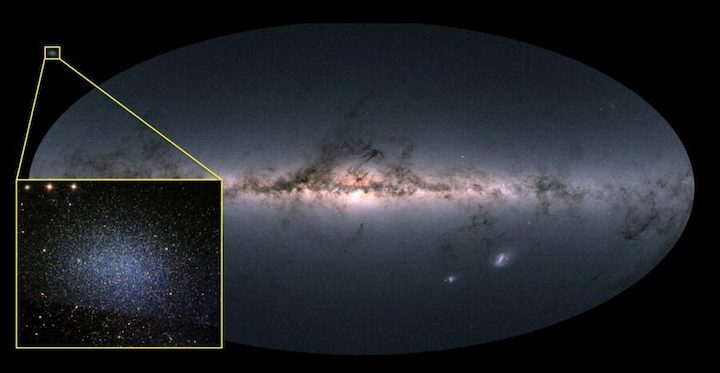10.12.2021

Leo I (inset) is a tiny satellite galaxy of the Milky Way (main image), but it has a black hole nearly as massive as the one at the center of our galaxy.
Main image: ESA / Gaia / DPAC; Inset: SDSS
All black holes are mysterious, but this one defies explanation.
At the center of Leo I, a dwarf galaxy about 100,000 times less massive than our own, astronomers have discovered a black hole nearly as big as the behemoth at the core of the Milky Way. No one knows where it came from or how it got there. Like finding the wreck of the Titanic at the bottom of a pond, the scales simply don’t match up.
“My first reaction was total disbelief,” recalls Maria José Bustamante-Rosell (now at University of California, Santa Cruz), who led the study published in The Astrophysical Journal. Her team examined the integrated light of stars in Leo I to measure how their typical speeds varied throughout the galaxy. In doing so, they noticed extreme motions around the center — telltale sign of the strong, concentrated gravitational pull of a black hole. By their estimate, the core of Leo I weighs in at 3 million times the mass of the Sun (though that value could range from 1.3 million to 5.3 million solar masses).
“I don’t think anyone expected this,” says Mark den Brok (Leibniz Institute for Astrophysics Potsdam), who was not involved in thes tudy. The discovery of a huge black hole in “such a wimpy galaxy,” he remarks, “is really surprising.”
Wimpy is a good way to describe it. Leo I is a dwarf spheroidal galaxy, meaning it is a small but massive group of stars. Though dwarf spheroidals are probably very common, they are so dim that astronomers have discovered only a few. This is the first time anyone has searched one for a black hole.
That’s because no theory has ever predicted something like Leo I. There are two known ways to end up with a supermassive black hole in a small galaxy: start with a huge galaxy and rip away most of the stars, or start with many small galaxies and combine them together. The first option would not leave enough of the galaxy behind, while the alternative, piece-by-piece growth, has never been known to make anything like Leo I.
There are caveats. “Leo I could very well be a weird one-off,” Bustamante-Rosell explains. Astronomers will have to look for more black holes in dwarf spheroidals to be certain something pathological is going on. If it is, then a crucial piece is missing from what we know about how black holes are born or how galaxies form — or maybe even both.
As den Brok puts it: “This might lead to a paradigm change.”
Quelle: Sky&Telescope

